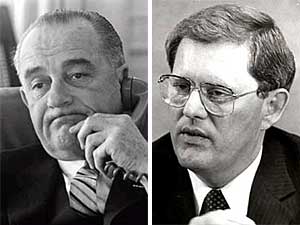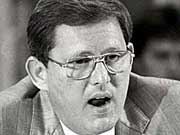Commentary: Lyndon Baines Janklow
January 21, 2004
 |
| Is there some LBJ in Bill Janklow? South Dakota State University history professor Jon Lauck says the two share a similar political style. (LBJ file photo; Janklow photo courtesy of the Argus Leader) |
Sioux Falls, S.D. — Four decades hence, some recipients chuckle at the "Johnson treatment," LBJ's often-menacing manner of squeezing a deal out of a fence-sitter. After the obligatory Johnson story, the chuckling recedes into a glowing judgment: "But he knew how to get things done."
Robert Caro, the great biographer of LBJ, struggled with his subject. He analyzed LBJ's foibles in excruciating detail but seemed to come away an admirer. For Caro, great deeds overshadowed the foibles. LBJ may have bullied people, but, after all, he defied the odds and passed the modern civil rights laws, reversing centuries of institutional segregation and racism and addressing the greatest stain on American history.
 | |||
With Caro's approach in mind, one could hazard the guess that historians will be kind to South Dakota's longtime governor, Bill Janklow, because of all he accomplished for his state. Moreover, historians adore great characters and grand narratives and can spend years sorting them out. Caro has been writing about LBJ for 20 years, after all. How many riveting biographies of Calvin Coolidge have you read?
When reviewing past South Dakota governorships, one is struck by how often the "history" of an administration consists of some mundane bureaucratic shuffling. Not so with Janklow. He worked in broad strokes. He liked big ideas and big plans. It's reminiscent of LBJ latching onto the early musings and memos that became the War on Poverty. "Now that's my kind of plan!" LBJ exclaimed.
Janklow's grand plans even seemed to have a touch of Texan. After the bankruptcy of a major rail line, Janklow passed a new sales tax to buy 1,300 miles of railroad track so farmers would have access to their markets. He changed the usury laws to lure Citibank to South Dakota, which then became the state's largest employer. He lured 100 businesses away from tax-heavy Minnesota, the catalyst for the border skirmishes with Minnesota governors from Rudy Perpich to Jesse Ventura.
In 1983, Time magazine described a Janklow-inspired "self-made, statewide economic renaissance" and called Sioux Falls a "new financial capital."
By no measure an ideological conservative, Janklow is a frontier, populist problem-solver. The biggest problem his state faced was economic development, the goal which unified all his grand plans, and leaves him more properly associated with 19th century Whigs than 20th century Reaganites.
|
Did Janklow's approach ... trump his accomplishments? One suspects not. Process arguments do not tend to wear well. Results do. But it will be years before historians can add up all the pluses and minuses and even attempt a calculation.
- Historian Jon Lauck |
To promote the technology and training necessary for development, Janklow wired all the schools in the state for Internet service before any other states had considered it, and transformed another of the state's universities into one of the nation's most-wired campuses. While some argue that schools suffered under Janklow's low-tax policies, others emphasize that low taxes are critical to the state's efforts to promote economic development.
Perhaps more than his policy accomplishments, historians will be riveted by Janklow's personal biography. While many South Dakota governors are Republican, technocratic, Norwegian and dull, Janklow's life may necessitate multiple volumes.
His Jewish father prosecuted Nazis at Nuremburg. He was wounded by the Red Chinese helping to defend the Taiwanese islands of Quemoy and Matsu. He signed on to LBJ's War on Poverty by serving as a Legal Services lawyer on the Rosebud Indian reservation, and he was South Dakota's lead prosecutor in the trials of the American Indian Movement. No other governors have had a firebomb tossed into their living rooms. No other governors have had to keep an M-16 handy.
The consistent criticism of Janklow is stylistic -— he didn't play nice. His first opponent for governor, Roger McKellips, framed the argument perfectly.
"His office did some good things, like Citibank, but his style of governing, running roughshod over people, made for more minuses than pluses."
Thus the critical question -- did Janklow's approach, as measured by the McKellips' calculus, trump his accomplishments? One suspects not. Process arguments do not tend to wear well. Results do. But it will be years before historians can add up all the pluses and minuses and even attempt a calculation.
In keeping with the past 30 years of theorizing in social history, the calculus must be attentive to whose arms were twisted, the strong or the weak. Much evidence to date indicates that Janklow was sympathetic to those on the margins. His career began defending Native Americans accused of crimes on Rosebud reservation (winning 30 acquittals in murder and manslaughter cases), and he was known to put on a Santa suit to deliver gifts to the humble homes on the reservation.
One can't forget that Janklow started his work as a lawyer in LBJ's War on Poverty, and he seemed to understand its premises. In 1979, he said, "I do think and believe that if you live on the wrong side of the tracks, people take a more jaundiced look at you than they do if you live on the other side of the tracks."
His long-time friend Jeremiah Murphy said it best. "Nobody at the country club impresses him." The perspective is reminiscent of LBJ, who was constantly aggravated by the flittings and musings of the Harvard aristocrats left over from Kennedy's Camelot.
Arthur Schlesinger Jr., the chronicler of Camelot and admirer of Adlai Stevenson, was enthralled by allusions to Aeschylus, presentations by Pablo Casals, and cerebral, ADA activism. Janklow's Corvettes, parasailing, water skiing, 1950s record collection, and blunt force approach to a malleable legislature would not have impressed him. If Caro applied his approach, he might be impressed. In the end, it depends on who is calculating the pluses and minuses.
Jon Lauck is an assistant professor of history at South Dakota State University
|
News Headlines
|
Related Subjects
|

